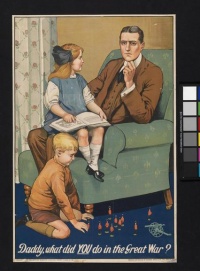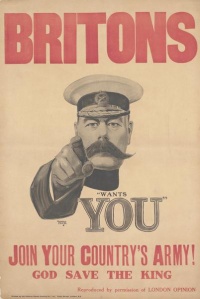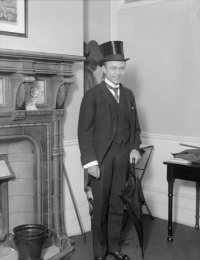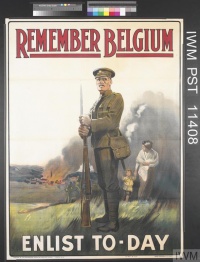Establishment↑
In the first weeks of World War I, the British government felt it was exposed to a rising flood of German propaganda. David Lloyd George (1863-1945), the Chancellor of the Exchequer, was asked to set up a British War Propaganda Bureau. He appointed Charles Masterman (1873-1927) to head the organization. Its offices were at Wellington House, the headquarters of the National Insurance Commission, over which Masterman presided. A major objective of his department was to encourage the United States to enter the war on the side of the Allies. It also supported and coordinated propaganda initiatives by private organizations and individuals.
Output and Distribution↑
In June 1915, the first report on the work carried out by Wellington House stated that it had published 2.5 million copies of pamphlets, books, and other means of propaganda in seventeen languages since the beginning of the war. By February 1916, the numbers had risen to seven million copies – leaflets not included.
One of the most significant publications to be distributed by the Bureau was the Report on Alleged German Outrages of May 1915, edited by the “Bryce Committee,” named after its Head James Bryce (1838-1922). The report documented actual and alleged atrocities committed by the German army against civilians in Belgium.
Wellington House’s output was distributed through unofficial sources concealing its links to the British government. All distributing bodies cooperated and were coordinated by Wellington House. Various voluntary organizations in Britain helped to spread pamphlets through their mailing lists. Another channel of distribution was the use of British embassies and consulates. They assisted in placing pamphlets of all kinds among others in waiting rooms, barbershops, and libraries.
Sir Gilbert Parker (1862-1932), head of the American department at Wellington House, in 1915, maintained a mailing list of 13,000 names, reaching 160,000 in 1917. In addition, Parker supplied 512 newspapers with propaganda material. This was distributed without mentioning Wellington House or any other government office. Until near the end of the war, only a handful of persons knew that the British government had a propaganda apparatus working in the USA.
Centralization and Abolishment↑
During the first years of the war, British propaganda at home and abroad was carried out by a number of government departments and agencies with overlapping responsibilities. A lack of coordination of all propaganda efforts in 1916 made necessary its centralization under the Foreign Office: The Neutral Press Committee was absorbed into the News Department, and Wellington House was placed under the control of the Foreign Office. In February 1917, official propaganda was further reorganized as a Department of Information under John Buchan (1875-1940), who reported directly to the prime minister. The News Department of the Foreign Office, the Neutral Press Committee (until then under the direction of the Home Office) and Wellington House were merged. Masterman continued to be responsible for war art, photographs, pamphlets, and books. In 1918, all activities were finally centralized under the new, completely independent Ministry of Information under Max Aitken, Lord Beaverbrook (1879-1964). Masterman was appointed Director of Publications, John Buchan Director of Intelligence, and Alfred Charles William Harmsworth, Lord Northcliffe (1865-1922), was put in charge of propaganda aimed at enemy nations. The ministry was dissolved on 31 December 1918. Wellington House not only succeeded in influencing public opinion all over the world in favour of the Allied cause; it also managed to obscure its links to British authorities.
Florian Altenhöner, Independent Scholar
Section Editor: Christoph Jahr












